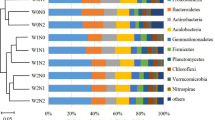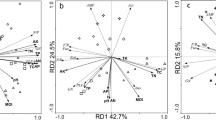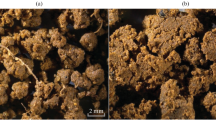Summary
Populations of several bacterial groups on the root surface of wheat and in root-free soil were investigated in volcanic ash soil and non-volcanic ash soil throughout a series of predetermined intervals. Over time, the populations changed similarly both on the root surface and in root-free soil. The numbers of total bacteria, fluorescent Pseudomonas spp., phosphate-solubilizing bacteria, and NH sup4inf+ -oxidizing bacteria, were consistently lower in the plots with volcanic ash soil than with nonvolcanic ash soil, but the numbers of cellulose-decomposing bacteria were opposite to those of the other groups. Superphosphate application improved the growth of wheat in the volvanic ash soil. It did not, however, bring about any significant changes in the bacterial populations among the volcanic ash soils supplemented with three different levels of superphosphate, though there were some variations with plant age.
Similar content being viewed by others
References
Adachi T (1971) On the area and humus content of Ando soils in Japan. Jpn J Soil Sci Plant Nutr 42:309–313 (in Japanese)
Arai S, Honna T, Oba Y (1986) Humus characteristics. In: Wada K (ed) Ando soils in Japan. Kyushu Univ Press, Japan, pp 57–67
Blair WC (1978) Interactions of soil fertility and the rhizosphere microflora of seedling cotton in relation to disease caused by Rhizoctonia solani. MS thesis, Auburn Univ, Alabama, USA
Bremner JM, Mulvaney CS (1982) Nitrogen-total. In: Page AL, Miller RH, Keeney DR (eds) Methods of soil analysis, part 2, 2nd edn. Am Soc Agron, Madison, Wisconsin, pp 595–616
Curl EA, Truelove B (1986) The rhizosphere. Springer-Verlag, Berlin Heidelberg New York Tokyo, pp 113–129
Hiltner L (1904) Über neuere Erfahrungen und Probleme auf dem Gebiet der Bodenbakteriologie und unter besonderer Berücksichtigung der Gründüngung und Brache. Arb Dtsch Landwirtsch Gesellsch 98:59–78
Inoue K (1986) Chemical properties. In: Ando soils in Japan Kyushu Univ Press, Japan, pp 69–95
Ishizawa S, Toyoda K (1964) Microflora of Japanese soils. Bull Natl Inst Agric Sci B 14:203–284 (in Japanese)
Katoh K, Itoh K (1983) New selective media for Pseudomonas strains producing fluorescent pigment. Soil Sci Plant Nutr 29:525–532
Japanese Society of Soil Microbiology (1975) Experimental method of soil microbiology. Youkendou, Japan, pp 444 (in Japanese)
Louw HA, Webley DM (1959) The bacteriology of the root region of the oat plant grown under controlled pot culture conditions. J Appl Bacteriol 22:216–226
Martin JK (1971) Influence of plant species and plant age on the rhizosphere microflora. Aust J Biol Sci 24:1143–1150
Matsuda K, Nagata T (1958) Effects of aluminium concentrations on microorganism multiplications. Jpn J Soil Sci Plant Nutr 28:405–408 (in Japanese)
Matsumoto H, Okada K, Takahashi E (1979) Excretion products of maize roots from seedlings to seed development stage. Plant and Soil 53:17–26
Miller HJ, Liljeroth E, Henken G, Van Veen JA (1989) Fluctuations in the fluorescent Pseudomonas and actinomycete populations of rhizosphere and rhizoplane during the growth of spring wheat. Can J Microbiol 36:254–258
Nelson DW, Sommers LE (1982) Modified Mebius procedure. In: Page AL, Miller RH, Keeney DR (eds) Methods of soil analysis, part 2, 2nd edn. Am Soc Agron, Madison, Wisconsin, pp 571–573
Parke JL, Liddeu CM, Clayton MK (1990) Relationship between soil mass adhering to pea tap roots and recovery of Pseudomonas fluorescens from the rhizosphere. Soil Biol Biochem 22:495–499
Rouatt JW, Peterson EA, Katznelson (1963) Microorganisms in the root zone in relation to temperature. Can J Microbiol 9:227–236
Rovira AD (1965) Interactions between plant roots and soil microorganisms. Annu Rev Microbiol 19:241–266
Sivasithamparam K, Parker CA (1979) Rhizosphere microorganisms of seminal and nodal roots of wheat grown in pots. Soil Biol Biochem 11:155–160
Skerman VBD (1967) A guide to the identification of the genera of bacteria, 2nd edn. Williams and Wilkins Co., Baltimore, Maryland
Truog E (1930) The determination of the easily available phosphorus of soils. J Am Soc Agron 22:874
Wada K, Harada Y (1969) Effect of salt concentration and cation species on the measured cation exchange capacity of soils and clays. Proc Int Clay Conf Tokyo 1:561–571
Author information
Authors and Affiliations
Rights and permissions
About this article
Cite this article
Jiang, HY., Sato, K. Fluctuations in bacterial populations on the root surface of wheat (Triticum aestivum L.) grown under different soil conditions. Biol Fert Soils 14, 246–252 (1992). https://doi.org/10.1007/BF00395459
Received:
Issue Date:
DOI: https://doi.org/10.1007/BF00395459




